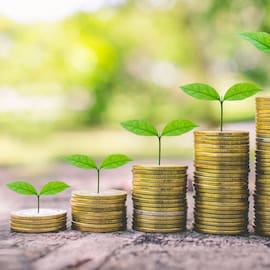After Kenyan entrepreneur Joy Obuya gave birth in 2019, she quickly spotted a gap in the local fashion industry: Finding chic clothing that catered to pregnant women and new mothers like her was almost impossible. And what was available mostly came from abroad and catered to Western women. So Joy sprang into action. In 2020, she founded Nawiri, a sustainable fashion brand primarily aimed at Kenyan mothers. But there was one big problem: She needed loans for her business to grow, and financial institutions kept turning her down, citing reasons that ranged from a lack of collateral to low revenue.
Unfortunately, Joy’s story is common across Africa, a continent where debt capital is the main source of financing for small and medium-sized enterprises (SMEs), and where an estimated $42 billion financing gap exists for SMEs owned or led by women. This gap has persisted despite the fact that women own the majority of the continent’s SMEs, and that globally, they default on their loans at a rate 53% lower than men.
Africa’s women-owned or -led SMEs (WSMEs) aren’t just potential engines of the continent’s economy. They are also driving growth that is inclusive and environmentally conscious. Nawiri, for instance, pays garment workers a livable wage, and is ramping up efforts to source its fabrics sustainably. So why aren’t businesses like Joy’s getting more financial support?
This is a question that has long concerned us at Open Capital. Since 2010, we’ve advised hundreds of African businesses that are supportive of, or owned and/or led by, women. We have also helped these businesses to raise more than $790 million in capital. In our experience working with these enterprises, we’ve observed two main barriers facing the continent’s female business owners. First, they don’t always qualify for existing types of loans. Second, financial institutions either do not have the expertise and capacity necessary to work effectively with prospective female borrowers, or they do not have products or pipelines that are suited to the nuances of female entrepreneurs’ needs. These challenges are not insurmountable, but solving them will require development organizations and financial institutions to come together and pursue new and creative solutions.
Identifying roadblocks to better financial inclusion for WSMEs
However, before workable solutions can be identified, it’s important to be clear on the main challenges. When a female small business owner like Joy walks into a commercial bank in an African country, the odds are already stacked against her. First of all, most commercial banks in Africa (and globally) prefer to serve large corporations rather than small-scale startups. That’s because big businesses tend to take up larger loans, consistently repay on time and contribute more to the bank’s bottom line.
Then there is the problem of collateral. Often, banks require small businesses to provide proof of existing assets — like a land title deed or a vehicle logbook — to secure a loan. But due to cultural and social norms in many African countries, women frequently live on property owned by their male relatives, and they don’t typically make other major purchases in their own names. Even when they co-own businesses with male relatives, these men are often unwilling to sign personal guarantees as an alternative to the collateral required by lenders. This frequently leads to women’s businesses being labeled as “high risk,” which either disqualifies them from loans entirely or burdens them with higher interest rates. In Ghana, for instance, according to 2023 data, interest rates are around 35% — and they can climb even higher for so-called high-risk borrowers.
Meanwhile, the odds are that the loan officer sitting across from a woman entrepreneur in the bank hasn’t been trained to spot gender-related nuances in applications, and neither has their credit risk department. Often, these employees rely on a set checklist of criteria to assess whether an applicant meets the requirements for a loan. Even in cases where the bank already has financial products targeted at women, bank employees may accidentally disqualify a candidate because she doesn’t meet the general loan requirements.
Finally, commercial banks exist to make a profit. They want to attract borrowers who are already qualified for their financial services. Small business owners, whether women or men, often lack the know-how to craft solid business plans, collect the required loan documentation or keep a proper accounting system. On top of this, we know that female entrepreneurs are more likely to be evaluated based on the risks of their businesses, while men are more likely to be judged on their businesses’ growth potential. All of this means that someone like Joy walks into a bank already poised to fail, despite her business’ undeniable potential.
Finding a new way forward for female entrepreneurs
So, what can development organizations and financial institutions do to ensure that promising female entrepreneurs like Joy have access to the capital they need to thrive?
First, they can build on what is already working. In recent years, we’ve been excited to see donors and other development partners link up with financial institutions to address the core challenges facing female business owners. They often do this by providing lines of credit and guarantees that allow financial institutions to lower their interest rates and collateral requirements for women borrowers without risking their own bottom lines. In Ghana, for example, the Mastercard Foundation works with ABSA, one of the country’s largest commercial banks, to provide loans to WSMEs with low collateral requirements and single-digit interest rates (compared to the prevailing rate of more than 35% that we mentioned above). Another great example is the African Guarantee Fund’s “risk sharing” partnership with the Kenya Women Microfinance Bank, which could provide as much as $22 million in new funding to WSMEs in Kenya.
However, while initiatives like these are moving the needle, they are not enough to accelerate financial inclusion for African women. Without the right incentives and support, there’s no guarantee that financial institutions will actually use these programs to bring in more female borrowers. These initiatives often have limited capacity to track how their funding is actually used, and the financial institutions that receive it may just invest the money in government bonds rather than on-lending it to WSMEs at lower rates, and then return it at the end of the program. Alternatively, they may lend from the fund but stop as soon as the agreement with the development partner ends, sending their female borrowers back to square one.
Therefore, for these kinds of initiatives to achieve systemic change, we believe they must be combined with other interventions, including:
- More tailored financial products: Financial institutions should focus on developing accounts and loan products that are specifically designed to address the barriers to access that women face. For instance, in contexts where many women do not have sufficient credit histories to qualify for loans, financial institutions and development partners can collaborate to use alternative measures of creditworthiness, like utility payments or mobile usage. Additionally, they can set lower minimum balances on accounts, or institute a longer repayment timeline, to support female customers with less access to capital.
- Incentives: Performance-based incentives for financial institutions that take on more WSMEs as clients can make those loans a win-win for lenders and borrowers. For example, during the pandemic, the International Finance Corporation developed a fund to support SMEs in low-income countries, enabling them to better navigate the impact of COVID-19. Up to $2.4 million was allocated to financial institutions that earmarked at least 20% of their working-capital loan proceeds for lending to women and women-led enterprises. Additionally, targeted blended finance solutions that combine commercial capital with concessional financing like grants, guarantees and sub-market rate loans all incentivize banks to lend to WSMEs.
- Technical assistance: Many financial institutions in Africa want to lend to more women, and many women in Africa want to secure loans, but both groups need help learning to work with each other. This includes support for financial institutions to streamline their due diligence and risk assessment processes, collect and report gender-disaggregated data on their borrowers, and upskill their teams to engage more effectively and sensitively with potential female clients. A great example of this kind of capacity building is the African Development Bank’s Affirmative Finance Action for Women in Africa, which has set up a facility managed by the Africa Guarantee Fund to provide technical assistance to both financial institutions and female business owners. Moreover, some financial institutions are already bundling loans for women with training and mentoring, such as First City Monument Bank of Nigeria’s SheVentures initiative.
‘It takes a woman entrepreneur to understand women’s unmet market needs’
It’s clear there is no silver bullet for increasing African women’s access to finance for their businesses. In addition to the steps proposed above, this will require policy changes by governments and central banks that remove regulatory barriers and create a more enabling environment for women’s financial inclusion.
The work, however, is worth the effort. We know that women invest far more of their earnings back into their families and communities than men do, and that diverse business leadership often leads to bigger returns. “When women-owned businesses thrive, women consumers do too,” explained Joy in a piece she wrote this year for the Cherie Blair Foundation. “It takes a woman entrepreneur to understand women’s unmet market needs. Knowing how our clothes fit our bodies, knowing what our challenges are, that’s something only a woman can do.”
Crystal Mugimba is a Principal, Millie Maina is a Project Leader, Shiemaa Ahmed is a Senior Associate and Nathalie Gogue-Ebo is a Partner at Open Capital.
Photo courtesy of PICHA Stock.
Publisher: Source link






